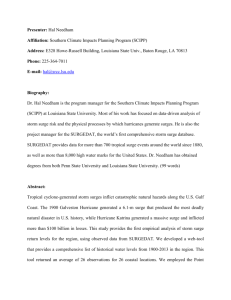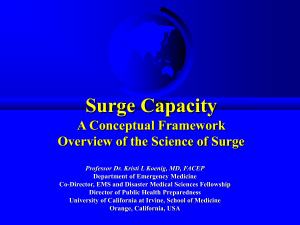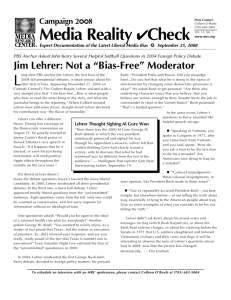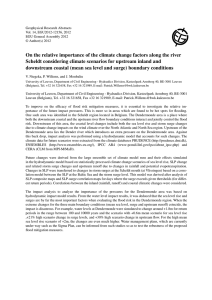`Surge` Strategy for No Child Left Behind?
advertisement
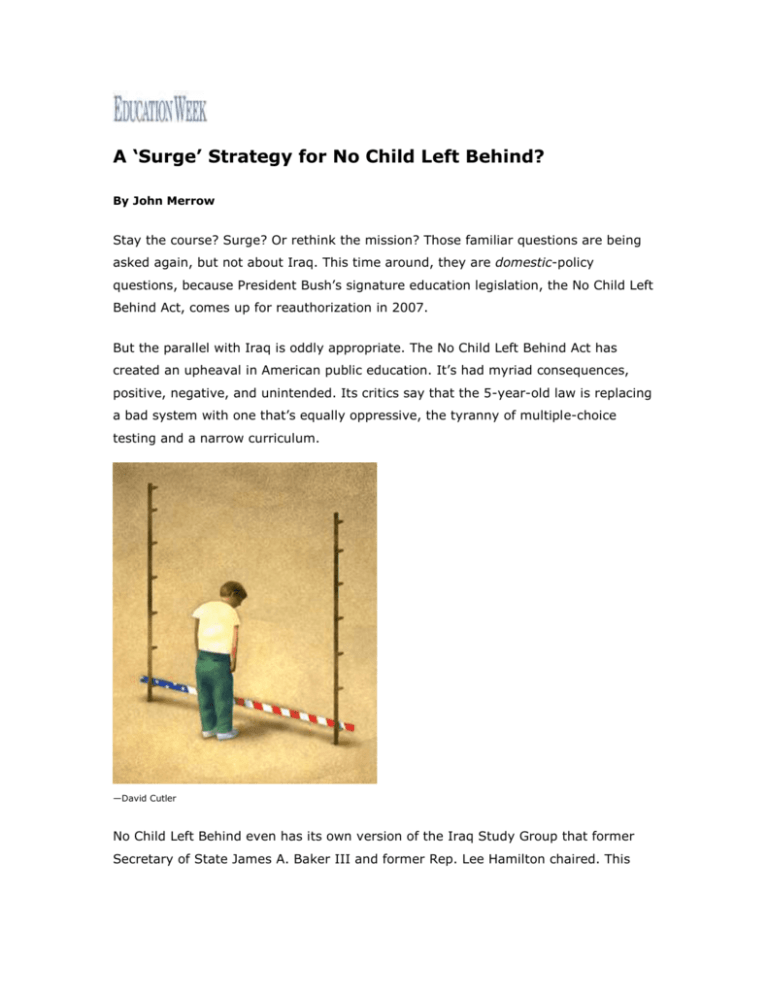
A ‘Surge’ Strategy for No Child Left Behind? By John Merrow Stay the course? Surge? Or rethink the mission? Those familiar questions are being asked again, but not about Iraq. This time around, they are domestic-policy questions, because President Bush’s signature education legislation, the No Child Left Behind Act, comes up for reauthorization in 2007. But the parallel with Iraq is oddly appropriate. The No Child Left Behind Act has created an upheaval in American public education. It’s had myriad consequences, positive, negative, and unintended. Its critics say that the 5-year-old law is replacing a bad system with one that’s equally oppressive, the tyranny of multiple-choice testing and a narrow curriculum. —David Cutler No Child Left Behind even has its own version of the Iraq Study Group that former Secretary of State James A. Baker III and former Rep. Lee Hamilton chaired. This national group, the Commission on No Child Left Behind, has as its chairs two former governors, Roy E. Barnes of Georgia and Tommy G. Thompson of Wisconsin. But unlike “Baker-Hamilton,” its report is endorsing a “surge” strategy of more federal involvement, more testing, and greater reliance on test scores. The commission, which was scheduled to issue its final recommendations this week, is calling for national standards and national tests, two related notions that have been anathema to most Republicans and many Democrats. Even though participation would be voluntary, states that chose not to participate would still be measured, publicly, against those that did. And while the No Child Left Behind law calls for publicly identifying failing schools, the Barnes-Thompson report goes beyond that to recommend identifying individual teachers whose students are not learning. Does this “surge” strategy make sense? It’s worth recalling the legislation’s history. The No Child Left Behind Act began with bipartisan optimism, thanks largely to President Bush, Edward M. Kennedy, D-Mass., in the Senate, and George Miller, DCalif., in the House. It’s quite possible that George W. Bush’s great contribution to American society may be the memorable phrase “the soft bigotry of low expectations.” The expression captures perfectly the hidden flaw in public education, pre-Bush: Because expectations matter, not expecting the best of all children is bigotry, pure and simple. By repeating this powerful insight at every opportunity, candidate and later President Bush made it impossible to ignore. That led directly to the No Child Left Behind Act, which set ambitious goals: fully qualified teachers in every classroom by 2006, and all children achieving at or above proficiency by 2014. It established sanctions, including the possibility that failing schools would be closed. But it also allowed states to set their own standards and choose their own measuring instruments. It’s painful to note that the No Child Left Behind Act has been responsible for increasing the “soft bigotry” that the bipartisan coalition hoped the law would eliminate. Because it demands that students demonstrate rudimentary math and English skills, and because education does testing on the cheap, we’re witnessing the narrowing of the curriculum and a dramatic increase in simplistic machinescored, multiple-choice testing—precisely at a time when the world economy demands not only higher skills but also different ones. Pressure on schools to make what the law calls “adequate yearly progress” and avoid sanctions has led to the narrowing of the curriculum. Science, art, music, history, and physical education are disappearing, while math and English have been “dumbed down.” A veteran English teacher in a low-income school in Virginia told “The NewsHour with Jim Lehrer”: “We used to spend time reading novels. I would love to do that, but now I need to spend my time focused on the bare necessities, those things that I know will be tested.” A veteran special education teacher in Maryland wrote that, because her school had failed to make AYP for the second year in a row and was at risk of being shut down, teachers there were now teaching to the test. Clearly distraught, she wrote, “In teaching to the test, I am afraid that we are raising a nation of idiots who may be able to pass standardized assessments without being able to think.” Matters are worst in low-income schools, where parents are relatively (or genuinely) powerless and pressures are greatest to close what’s generally referred to as “the achievement gap.” Schools for the poor are often dreary institutions with heavy emphasis on repetitive instruction, because the goal is passing the test, not genuine education. One veteran middle school math teacher put into words what was observably true: “They’ve got to pass the test. Some of the kids aren’t going to learn all the concepts, but if they have some of the strategies, they still can pass.” A teacher in a wealthy community—think Larchmont, N.Y.; Greenwich, Conn.; McLean, Va.; Winnetka, Ill.; or Palo Alto, Calif.—who expressed that view or taught that way would be out of a job within a week, and perhaps by sundown. But don’t put the blame on educators. The fault lies with our miserly, backwardthinking approach to testing and assessment. Public education does testing on the cheap. In the report “Margins of Error: The Education Testing Industry in the No Child Left Behind Era,” Thomas Toch of the Washington-based group Education Sector estimates that state spending on No Child Left Behind-related testing was less than $750 million last year, out of a total K-12 spending of more than $500 billion. In other words, for every $100 we spend on K-12 education, we devote 15 cents to testing and measuring. Even Massachusetts, which takes its responsibility as seriously as any state in the union, only devotes less than 1 percent of its education dollars to testing. By contrast, chemical-engineering companies spend at least 3 percent or 4 percent on research and evaluation, according to M. Blouke Carus, a chemical engineer who is better known for developing the Open Court reading program and, with his wife, Marianne, the Cricket, Ladybug, and Spider magazines for children. And the pharmaceutical giant Bristol-Myers Squibb spends 16 percent of its revenue on research and testing. Imagine the outrage if Toyota, Gerber, Heinz, or Hartz Mountain spent only a fraction of a percent of their revenue testing the products they want the public to use. The No Child Left Behind law has actually undermined earlier efforts by some states, including Connecticut, Kentucky, Maryland, Nebraska, and Oregon, to develop sophisticated tests that include analytic essays, research papers, science inquiries, complex mathematical problems, and projects. Citing the law, the U.S. Department of Education has “encouraged” these states to abandon the complex parts of their assessments in favor of off-the-shelf multiple-choice tests. Maryland and some other states complied, Nebraska fought back and seems to have gotten its system approved, and Connecticut has sued. By aiming too low, the No Child Left Behind Act is endangering our economic future. It is becoming increasingly clear that any job that can be outsourced will be. Princeton University economist Alan Blinder has observed that the key to survival in the American economy will not be the number of years of education completed (as has been true), but the kind of education one receives. Train for jobs that cannot be off-shored (doctor or plumber), he advises, or become creative and adaptable, because that will empower you to create jobs and job opportunities. What should be done about No Child Left Behind? A group called the New Commission on the Skills of the American Workforce is calling for a “far-reaching redesign” of American public education, including merit pay for performance, national negotiations for teacher contracts, and allowing independent contractors to run public schools. ("U.S. Urged to Reinvent Its Schools," Dec. 20, 2006.) In a culture in which government institutions change slowly, these sweeping demands may relegate this important report to the bookshelf, to gather dust with hundreds of other national commission reports. But even if those changes were to come to pass, they would not save the No Child Left Behind law. Neither would the changes some superintendents are asking for, such as more time to reach proficiency, greater incentives to succeed, or waivers for students with special needs. That’s tinkering at the margins. In August, Secretary of Education Margaret Spellings compared No Child Left Behind to Ivory soap, calling it “99.9 percent pure.” Her new mantra—“mend it, but don’t end it”—also falls short, because the law needs more than a simple repair job. And Democrats in Congress say the administration’s call for vouchers is “dead on arrival.” Because of No Child Left Behind, teachers are teaching to the test. That would not be a bad thing if the curriculum were sufficiently challenging, so that passing the tests demanded a convincing demonstration of clear thinking, creativity, and mastery. The exams that students in International Baccalaureate programs have to pass are all these things, and IB faculty members quite properly “teach to the test.” But the “No Child” tests and the typical public school curriculum aim too low. Schools need integrated approaches to curriculum, like Seeds and Roots, which integrates literacy and science for early-elementary students, and high school courses in economics such as those advocated by the National Foundation for Teaching Entrepreneurship. Challenging curriculum is available, but setting the bar higher isn’t sufficient. Because testing drives curriculum, more money and energy must be devoted to developing sophisticated testing instruments. But that would create another problem—education doesn’t have enough sophisticated test-makers. Where are they? They’re probably working for Hartz Mountain, Squibb, Gerber, and other companies that spend serious money on evaluation. “Will this be on the test?” Teachers have grown accustomed to hearing that question from their students, but, ironically, they’re the ones now doing the asking, largely because of the No Child Left Behind Act. That perversion of education has to be addressed. As the law enters its sixth year, “staying the course” would be disastrous for public education and, eventually, American society. But a “surge” strategy won’t save the No Child Left Behind Act either. Washington insiders say there’s no rush to reauthorize the law, particularly with a presidential campaign already under way. We ought to use the time to debate the kind of education we want for our children, an opportunity that should not be missed. John Merrow is the education correspondent for “The NewsHour with Jim Lehrer” on PBS and a visiting scholar at the Carnegie Foundation for the Advancement of Teaching, at Stanford University. Vol. 26, Issue 23, Pages 32,44

